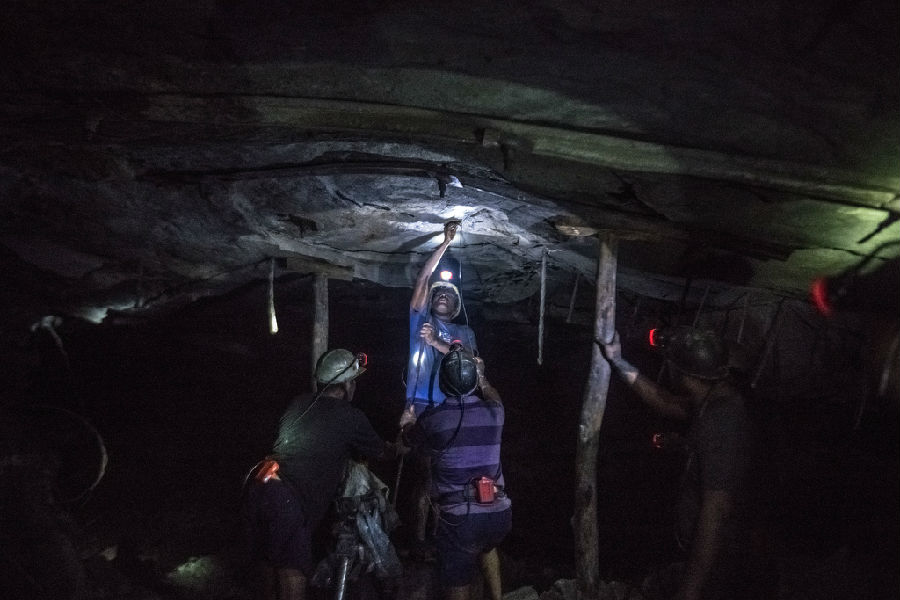On a warm Tuesday in October, about a four-hour drive from Hyderabad, the capital of Telangana,
十月一個溫暖的周二,距泰倫加納邦首府海德拉巴約4小時車程的地方,
an army of men in indigo shorts went underground to dig it out.
一群穿著靛藍色短褲的人正要到地下挖煤。
A simple pulley drew them in, a bit like a ski lift, except here, it took them deeper and deeper down a shaft.
一個簡單的滑輪車,有點像滑雪場的纜車,把他們載了進去,只不過這里的滑輪是將他們送往越下越深的豎井里。
The creak of the pulley was all you could hear, and water, drip-dripping inside the earth.
你只能聽到轆轤的吱吱聲,還有水在地底滴噠流動的聲音。
Here and there, off to the side, stood miners, their forms barely visible in the darkness,
滑輪兩邊不時會看到站著的礦工,除了纏繞在他們身上的手電筒發(fā)出的光,
except for the belted flashlights that snaked across their bodies.
他們的身影在黑暗中幾乎完全看不見。
At about 900 feet below the surface, where the air was black and cool and the coal under our feet was squishy,
在地下大約900英尺(270多米)的地方,環(huán)境又黑又涼,我們腳下的煤塊很軟,
a burst of explosives broke down a wall of coal.
用炸藥一炸,就炸開了一堵煤墻。
Small, sooty chunks were piled into tubs and wheeled out,
又小又黑的煤塊被裝進桶里,用滑輪運出去,
then loaded onto coal trucks that hurtled down the country roads, sprinkling a layer of ash everywhere.
然后裝上運煤的卡車,卡車奔馳在鄉(xiāng)間的道路上,所到之處,無不給周圍蒙上一層煤灰。
So deeply is India invested in coal, this, like other mines, is state owned.
印度十分器重對煤炭的投資,所以,這座礦廠,和其他礦廠一樣,都是國營的。
So are most power plants.
大部分發(fā)電廠也不例外。
Coal subsidizes the country's vast rail network.
煤炭支撐著印度龐大的鐵路網(wǎng)。
That person at the top of that system, India's prime minister, Narendra Modi, has sought to cast himself as a champion of clean energy.
位于這一網(wǎng)絡(luò)頂端的是印度的總理納倫德拉·莫迪,而他一直試圖把自己塑造成清潔能源至上的形象。
But Mr. Modi has been inaugurating new coal mines, too.
但莫迪也一直在不斷開辟新的煤礦。
His government has made it faster for industry, including mining, to get environmental clearances, rankling environmentalists.
他的政府還加快了包括采礦業(yè)在內(nèi)的工業(yè)獲得環(huán)境許可的速度,惹得環(huán)保主義者們憤恨不已。
India's state-owned companies are building new coal-fired plants across the country,
印度的國有企業(yè)正在全國各地興建新的燃煤電廠,
almost all of them financed by public sector banks.
幾乎所有這些電廠都是由國營銀行提供資金的。

In an interview in the capital, New Delhi,
在首都新德里舉行的一次采訪中,
India's energy secretary, Ajay Bhalla, said some 50 gigawatts of additional coal capacity were under construction.
印度能源部長阿賈伊·巴拉表示,有一個煤炭產(chǎn)能約為500億瓦的項目已經(jīng)在建設(shè)中了。
That's a fraction of what was under development even a decade ago, when India's energy demand was projected to soar.
就是跟十年前,印度的能源需求預(yù)計將大幅增長的時候相比也只是九牛一毛。
Many of those plants are meant to replace older, more polluting ones.
這些工廠有許多都是為了取代舊的、污染嚴(yán)重的工廠而建的。
But coal would not sunset anytime soon, he predicted,
但他預(yù)測,短時間內(nèi),煤炭并不會從印度消失,
not until there's a cheap and efficient way to store energy from solar and wind energy.
除非有廉價且有效的儲存太陽能和風(fēng)能的辦法。
Analysts say India must retool its electricity grid for the post-coal era.
分析人士稱,印度必須革新其現(xiàn)有電網(wǎng),迎接后煤炭時代的到來。
Battery technology is fast advancing.
電池技術(shù)發(fā)展迅速。
Microgrids can replace traditional electricity systems.
微型電網(wǎng)可以取代傳統(tǒng)的電力系統(tǒng)。
Many existing coal plants are now running below capacity, several are idle,
許多現(xiàn)有燃煤電廠目前都是在低負(fù)荷運轉(zhuǎn),還有幾家已經(jīng)閑置,
and new energy efficiency standards could slow down demand to the point where there may be a glut of costly coal-fired plants.
新的能效標(biāo)準(zhǔn)可能會將需求放緩到成本高昂的燃煤電廠供過于求的地步。
Left holding this bundle of stranded assets: The public sector banks that financed them.
這些擱淺的資產(chǎn)就會落到為它們提供融資的國營銀行手里。
For now, though, coal accounts for 58 percent of India's energy mix.
不過,目前煤炭在印度的能源結(jié)構(gòu)中還是占到了58%的比例。
It's not that I'm using the coal very willingly,” Mr. Bhalla said. But I have to."
“并不是我樂意使用煤炭的,”巴拉說。“我也是迫不得已啊。”
譯文由可可原創(chuàng),僅供學(xué)習(xí)交流使用,未經(jīng)許可請勿轉(zhuǎn)載。


